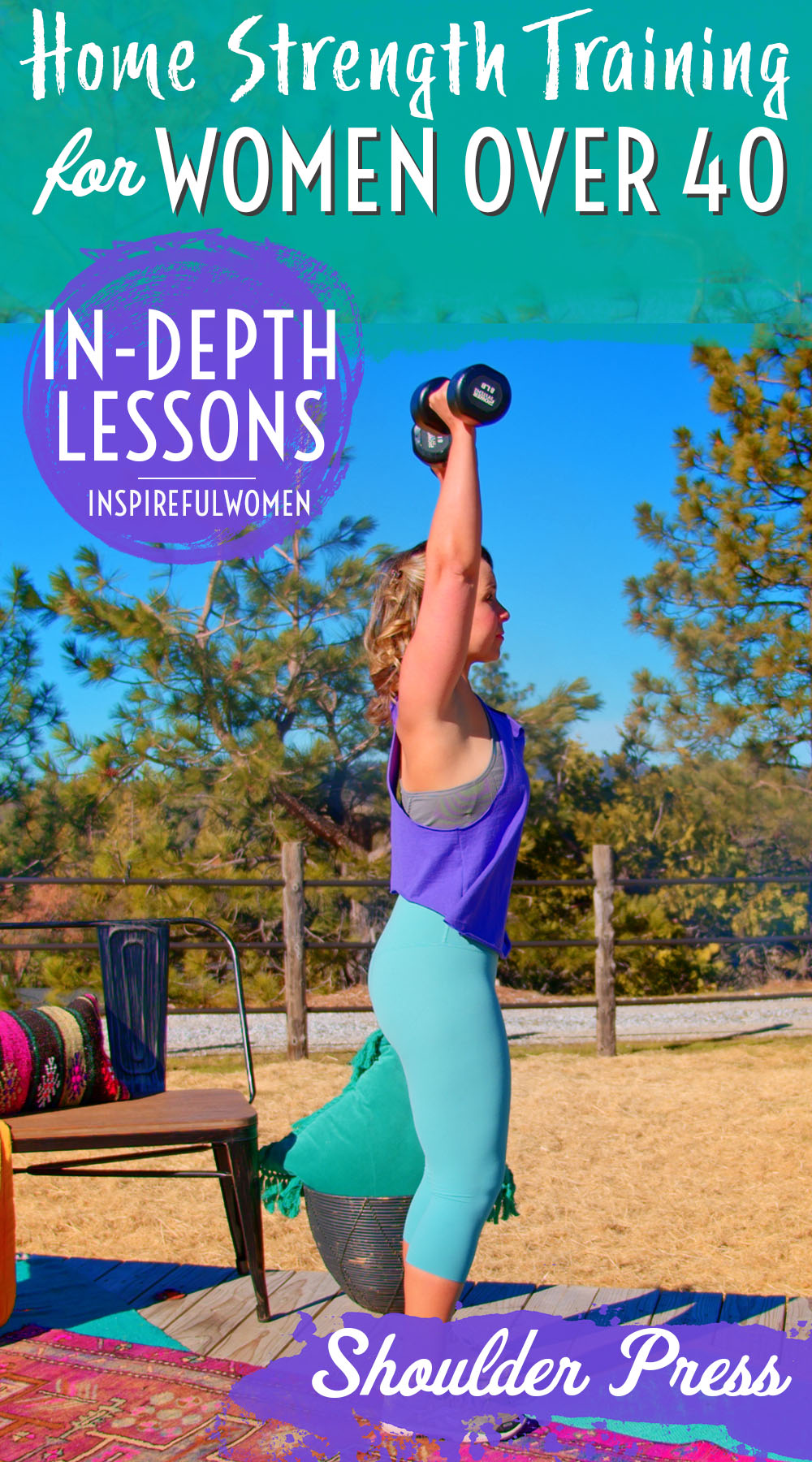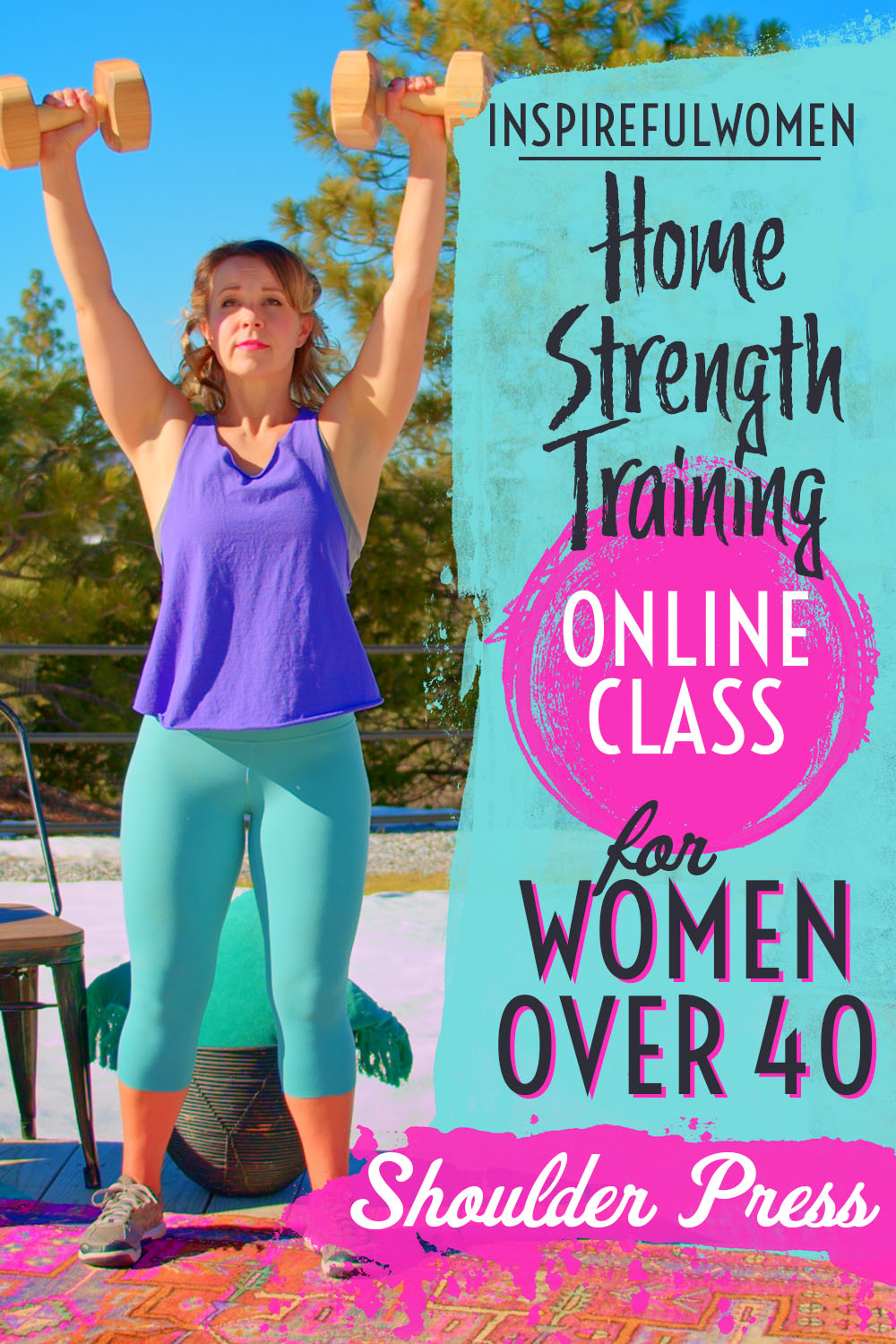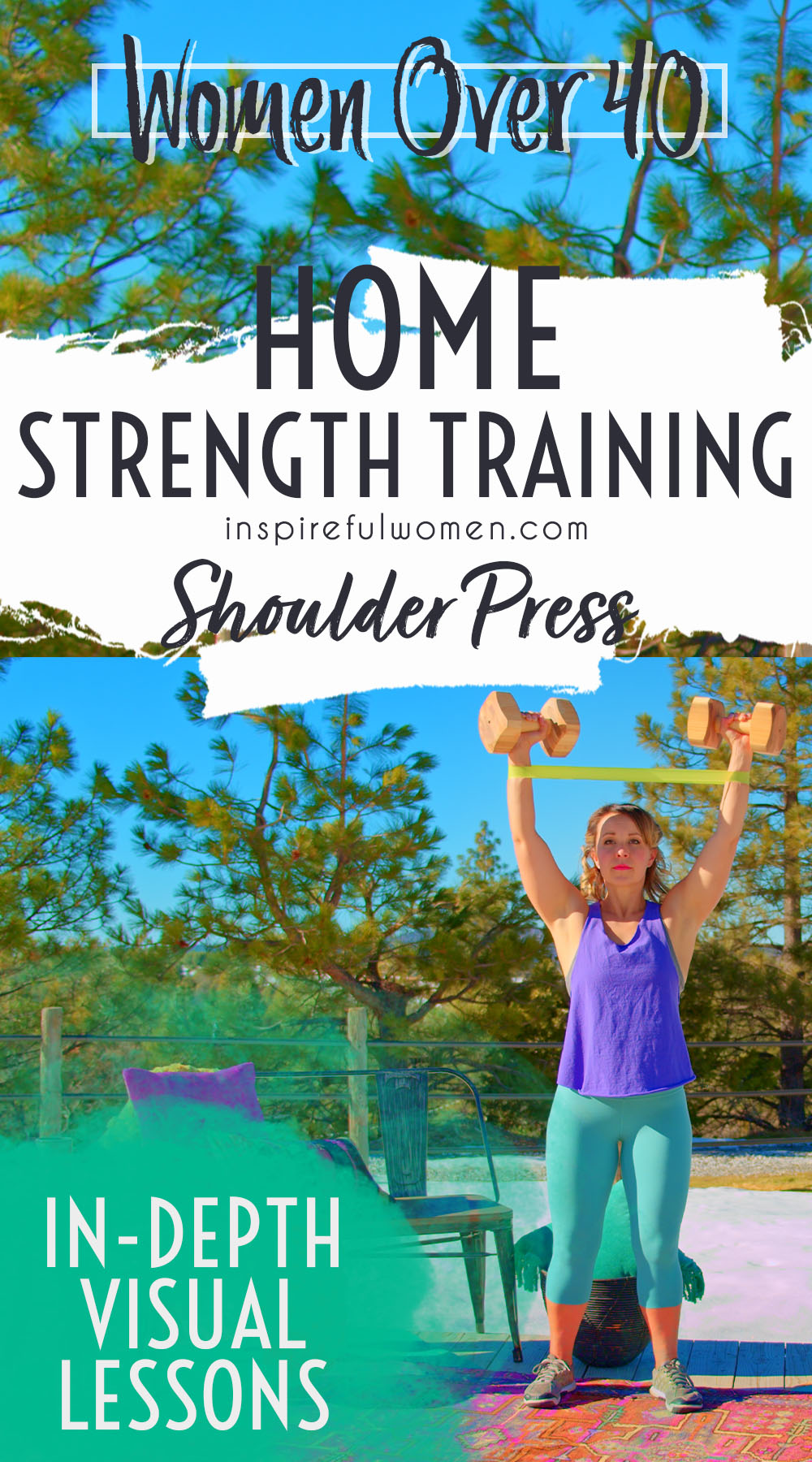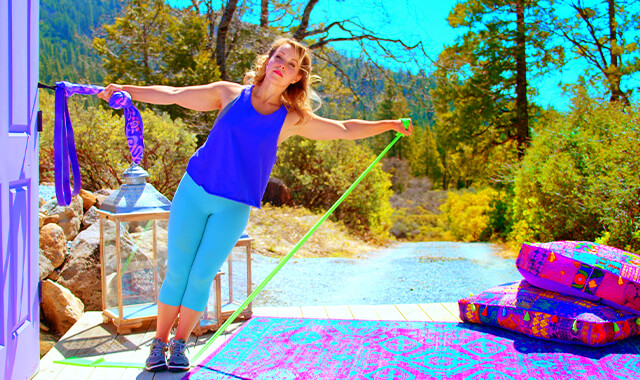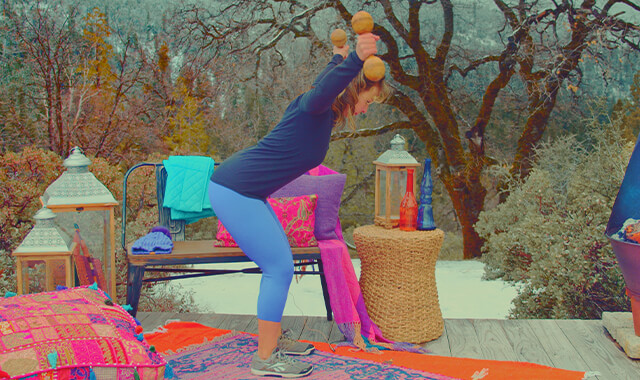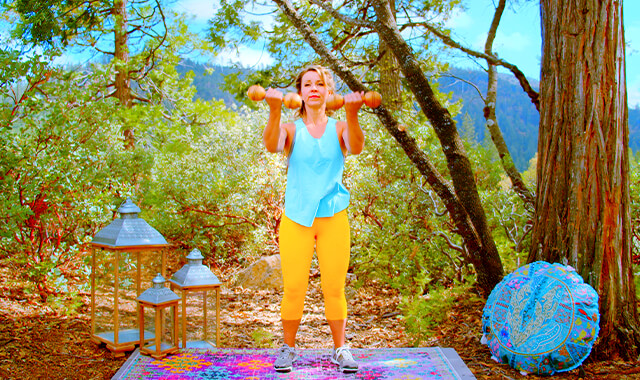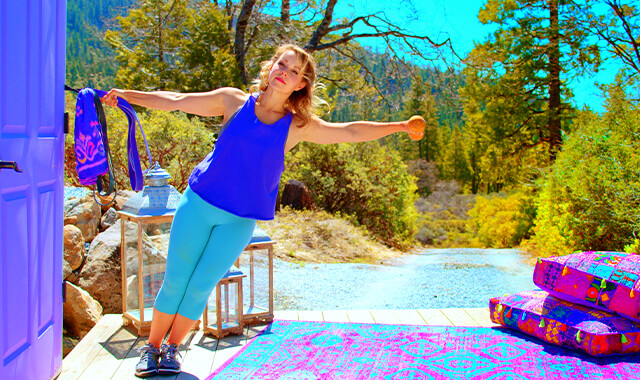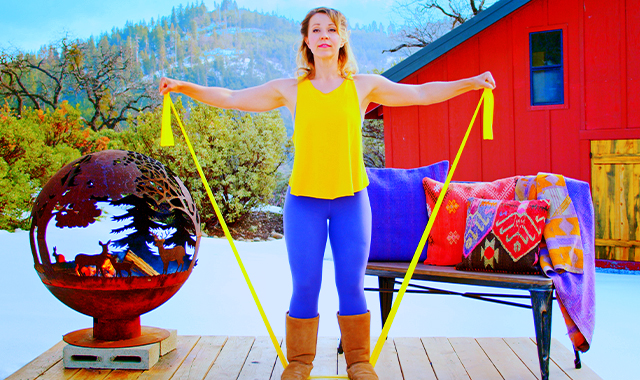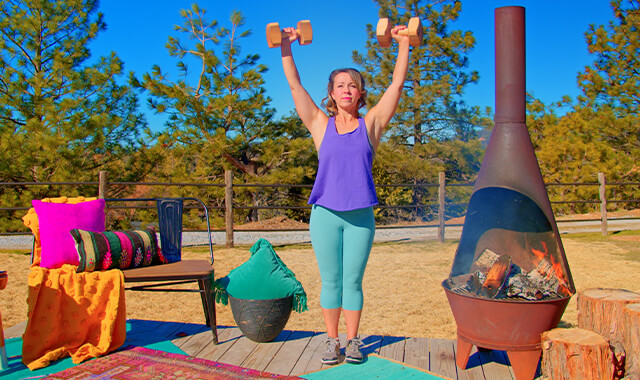Dumbbell Shoulder Press
How to Do the Standing Dumbbell Overhead Shoulder Press | In-Depth Guide [VISUAL LEARNERS]
Proper Form, Common Mistakes, & Variations | Home Resistance Training
WHAT DO YOU WANT TO SEE?
QUICK DEMO
QUICK DEMO
MUSCLES THIS WORKS
MUSCLES
MAIN MUSCLES WORKED IN the Standing Dumbbell Overhead Shoulder Press
Anterior & Lateral Deltoid
OTHER MUSCLES WORKED:
- Triceps
- Rotator cuff
- Scapular muscles: latissimus, trapezius, rhomboids, pectorals, serratus anterior
WHAT WE'RE DOING TODAY
WHAT & WHY
BENEFITS OF TRAINING THE Anterior & Lateral Deltoids
WHAT
WHAT WE'RE DOING TODAY
ALL WE'RE DOING:
Pressing our arms up overhead.
MIMIC DYNAMIC MOVEMENTS WE DO EVERY DAY
The standing overhead shoulder press is a compound exercise which means that we are moving more than1 joint - in this case, two - the shoulder & elbow - & the more joints that are involved in the movement, and the more range of motion there is, the more muscles are involved - which is great for efficiency. As well as practical! Our everyday life usually consists of dynamic movements that utilize a variety of joints & muscles all at once.
That said, compound movements are also very taxing & for people like me with energy issues, I find sprinkling these in is the better choice rather than having them be the main part of most of my workouts.
The shoulder press movements work the muscles responsible for pushing objects up over your head. This seems a pretty simple movement, but there is a lot going on. This exercise involves taking the shoulder joint up towards the end of the movement of the joint. The middle part of the spine (our thoracic area) needs to extend a little bit.
The muscles of the upper back and rotator cuff are very busy making sure that the shoulder joints move correctly, and are held still when they need to - to prevent injury to the very mobile shoulder joint. Once the arms are taken overhead, the elbows press the weight up higher. Moving the weights further away from your body will make the muscles of the torso work harder. As you press the weight up overhead, make sure to listen to what your body is telling you.
This exercise is done in the scapular plane - this means that the arms are not straight out to the side - but slightly in. This is the position that you would hold your arms if you were holding them up to give someone a BIG hug. This is also the position that we use our arms in most throughout the day. It is a position where there is less stress on the shoulder joint - so a better position for lifting weights overhead.
WHY BOTHER DOING IT?
WHY
WHY DO WE EVEN CARE?
BE ABLE TO KEEP DOING STUFF ABOVE OUR HEADS
Most of us have things we need to do with our arms overhead - whether that’s doing our hair or putting boxes of seasonal stuff away at the top of some closet out of the way. The shoulder press can be a very functional exercise for improving your ability to safely lift objects overhead. Many muscles and joints are involved in the movement - making it a nice upper-body exercise. Not only will you work all of the rotator cuff muscles, the muscles that move and stabilize the shoulder joint, and the muscles that lift and straighten the arm, but you will also work your core muscles.
IMPROVE STABILITY OF A NOTORIOUSLY UNSTABLE JOINT
This point comes with both encouragement & caution.
The overhead shoulder press exercises take the shoulder joint up near the end of its range this puts many of the muscles in a position where they are weaker - both in strength & stability.
What does that mean? As an example, if you think about holding something that has some weight to it, say a large bag of flour - typically, where we will we naturally carry it? Usually somewhere close to our body right? Perhaps close to our chest. This makes us feel stronger & more stable with the item. When we take that same bag of flour, and hold it way out in front of us or way above us and walk around with it, now there are two things:
- It feels a lot heavier than when we held it to our chest just a second ago even though the bag itself doesn’t suddenly weigh anymore, and
- Now we feel Iike we have to concentrate a lot more for that heavy item to not cause a part of our body to move in some direction we didn’t intend it to (& potentially hurting that body part when it moves in a way it shouldn’t have).
So from this what you can see is that when we take our joint to it’s further ranges of movement, with a load in our hands, the joint is not nearly as stable- it’s more vulnerable.
The ENCOURAGEMENT here is:
Overhead presses can help strengthen the muscles that stabilize our shoulder joint in this further range, which can protect against injury to our joint when we go about our life doing our overhead stuff (which hopefully doesn’t include carrying houseplants above your head). Whatever you do frequently, whatever you train for, you will increase your ability to do that thing healthfully - when you are untrained for an activity is when you get hurt right?
but. The CAUTION IS:
the exercises need to be done with this in mind, that the shoulder joint is unstable. Start slowly and progress slowly - always being mindful of how you are moving and what you are feeling.
The Gist of the balance between: This is Great! But wait, be careful:
The point is, by mindfully training our shoulder joint & muscles to move overhead with good form, we may increase the stability & strength of the unstable shoulder joint, helping to protect it from injury, buttttt at the same time, because it’s an unstable joint, to begin with, if we approach this movement unwisely, we are also more likely to get injured. So we will start with a light weight & have it feel almost too easy to begin with.
STRETTTTCCCHHHH OUR MID-BACK AREA
The other bonus of this exercise is that taking the arms overhead will move the middle part of the spine (thoracic spine) into a more extended position. This is excellent because as we age, our upper backs tend to start rounding forward - this is due to poor posture, tight chest muscles, tight thoracic spine, and weak upper back muscles. Osteoporosis and osteopenia (low bone density) can also affect this. The overhead shoulder press will take the middle part of the spine into a more extended position and strengthen the muscles needed for good upright posture.
EVERYDAY LIFE
EVERYDAY LIFE &
MUSCLE FUNCTION
HOW WE USE OUR Front & Middle Deltoid IN EVERYDAY LIFE
1. ANTERIOR FIBERS ACT TO LIFT THE ARMS OUT TO THE FRONT AND OVERHEAD
- Reaching into a cabinet - in front or higher shelves
- Washing windows
- Painting walls and ceilings
- Changing light bulbs
- Picking items up from the floor
2. LATERAL FIBERS ACT TO LIFT THE ARM OUT TO THE SIDE
- Lifting heavy objects (buckets, water softener salt bags) by the side of the body
- Dressing the upper body
- Washing hair
3. STABILIZING THE SHOULDER JOINT AGAINST A DOWNWARD PULL
- Walking a dog on a leash
- Holding a toddler’s hand
- carrying suitcases, buckets, water softener salt bags (heavy objects) by the side of the body
STARTING POINTERS
Starting Pointers
This is the standard version of the shoulder press. The standing position will work the muscles of the core and the legs. This is a great way to improve your posture - be mindful of how you are standing and what you are feeling. This version uses dumbbells as opposed to a bar, which works the stabilizing muscles of the shoulder and the arm more than the bar.
HOW TO FEEL WHAT MUSCLE IS WORKING
How to Feel What Muscle is Working
This is the most superficial muscle of the shoulder. Place a hand on the opposite shoulder and lift the arm up - you will feel the muscle activate under your hand.
Try lifting to the front to feel the anterior fibers, and lift to the side to feel the lateral fibers.
HOW TO DO THE EXERCISE
LOOKS
HOW Dumbbell Shoulder Presses SHAPE OUR BODY
Toned and defined shoulders and arms. Less rounded back - improved posture.
PROPER FORM
PROPER FORM: Dumbbell Shoulder Press
EQUIPMENT, SETS & REPS
EQUIPMENT
SUGGESTED STARTING WEIGHT FOR WOMEN:
5 - 10 lbs. With time, this is the sort of movement that you can eventually even use 20 lbs each arm potentially.
SETS & REPS:
1 - 2 sets of 6 - 8 reps
PACE:
Moderate but controlled pace, with emphasis on control as you lower press the weight up and lower it back down.
BODY POSITION
BODY POSITION FOR THE Dumbbell Shoulder Press
FEET/LEGS: Standing with feet shoulder-width apart. Your feet, knees, hips, and shoulders should all be in direct alignment or “stacked” properly. Your knees should be slightly bent.
BODY STANCE: Neutral spine, sternum lifted. Shoulders and pelvis squared to the front.
HAND/GRIP: Comfortable grip on the handles of the dumbbells, your palms can face forward or in towards each other -or somewhere between the two positions, slightly angled. The most important thing is that you are able to complete the exercise without discomfort, you can adjust the grip to a position of comfort as needed - they may tend to naturally rotate so that your thumb points slightly behind you - that is absolutely fine.
ARMS: Upper arms down by your sides. Arms in the scapular plane - as if you were opening your arms to give a very big person a hug. Elbows bent holding dumbbells at your shoulders, and dumbbells parallel to the ground. With your upper arm in the scapular plane - your elbows will be slightly towards the front of the sides of your torso - the tip of your elbow pointing towards the floor. Your hands over your elbows.
HOW TO DO
HOW TO DO Dumbbell Shoulder Presses
CUE: As you press up, pull your upper arms in close to your ears.
Push the weights straight up overhead, pressing both dumbbells up at the same pace.
Continue pressing until both elbows are fully straightened but not locked.
Reverse the movement by bringing the weights back down until your upper arm is parallel to the floor, ready for the next rep.
Why only to parallel: Only to parallel to keep the muscle tension on the deltoid. Once your upper arm is below parallel the load will decrease - but it is fine to go a lower (just not all the way down to the side) to work the muscle through a larger range. I always think of the overhead press as one that is working from 90 degrees and up, and the lifts work from 0 to 90 degrees. But, I don't know why you couldn't combine them if you wanted as long as you were not using too much weight.
From 0 to 15 degrees of flexion the supraspinatus will be doing more of the work than the deltoid, so if you are lifting a lot of weight it could overload and injure the supraspinatus.
HOW TO SAFELY GET OUT OF THE EXERCISE
From overhead position, control weights down to shoulders, and then to your side. Place weights onto the floor by bending at your knees and hips.
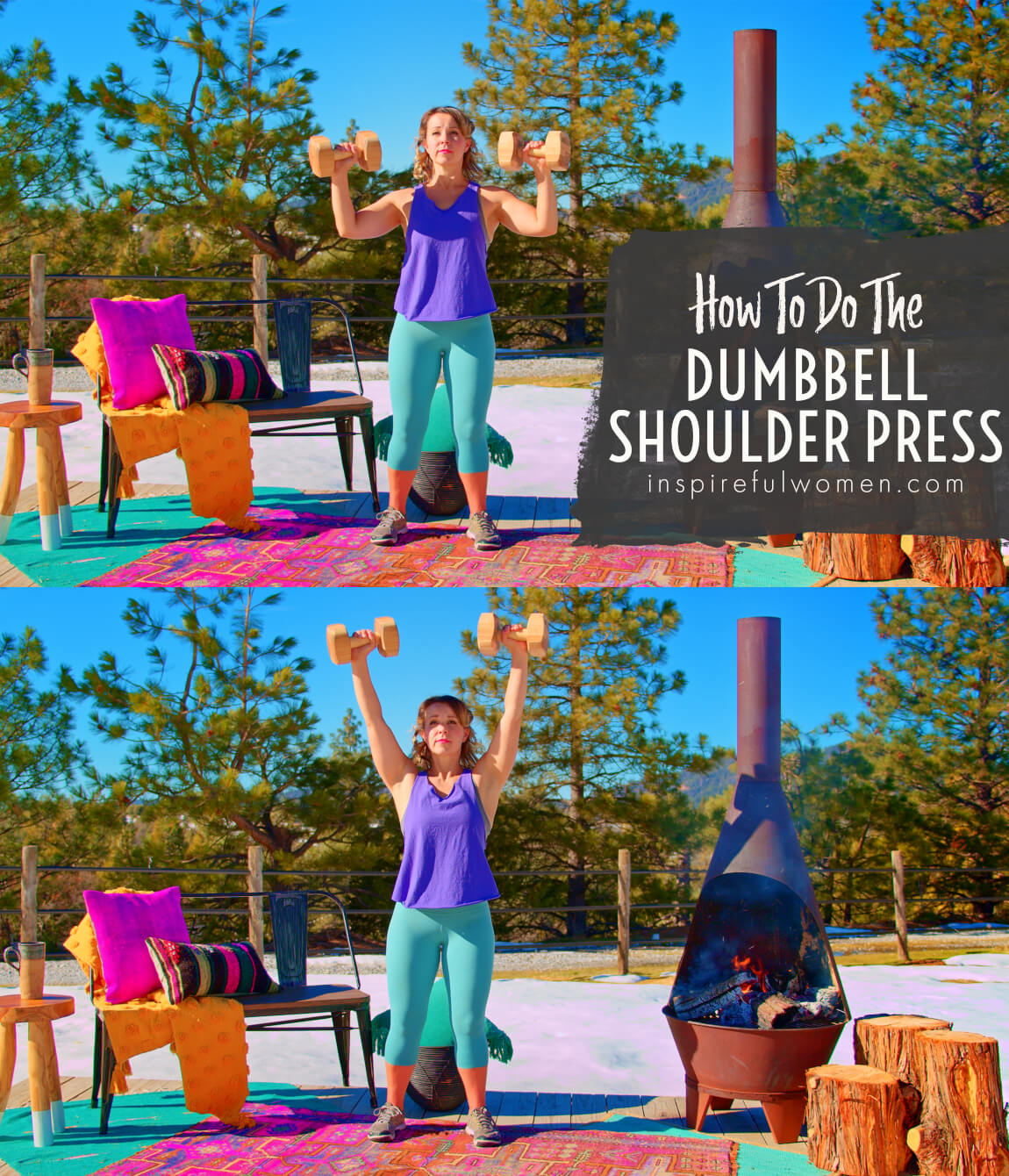
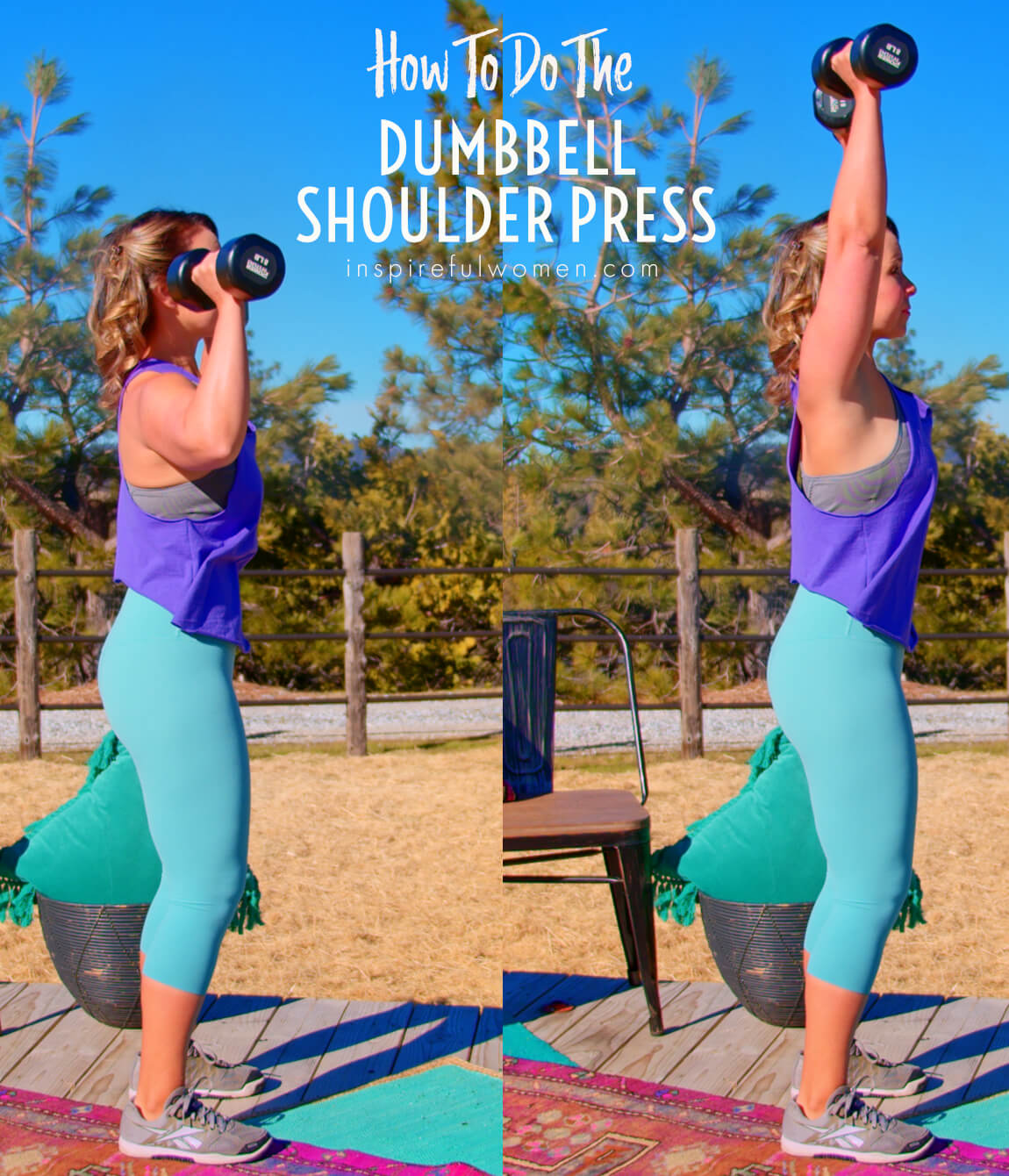
COMMON MISTAKES
COMMON MISTAKES
WHAT TO AVOID WITH THE Dumbbell Shoulder Press
KEY TIP:
Guess what? Good news! Many avoids are the same for most movements. Once you learn the basics, there's really only a few extra avoids for each individual movement.
1. Avoid Moving Torso
AVOID: Moving the trunk forward or backward to help with pressing the weight.
WHY NOT?
- This indicates that you are moving through the spine which can lead to a muscle strain of soft tissue/joint injury or damage over time.
- If you feel your weight shifting from the ball to the heel of the foot you may be moving the body.
WHAT TO DO:
- Try bending your knees more, and/or widening your stance.

2. Avoid Pulling Hands Behind You
AVOID: Letting the weights pull your hands back behind you.
WHY NOT?
- This can stretch the tissues on the front of the shoulder leading to shoulder instability. It can also cause you to arch your lower back which may lead to injury or damage over.
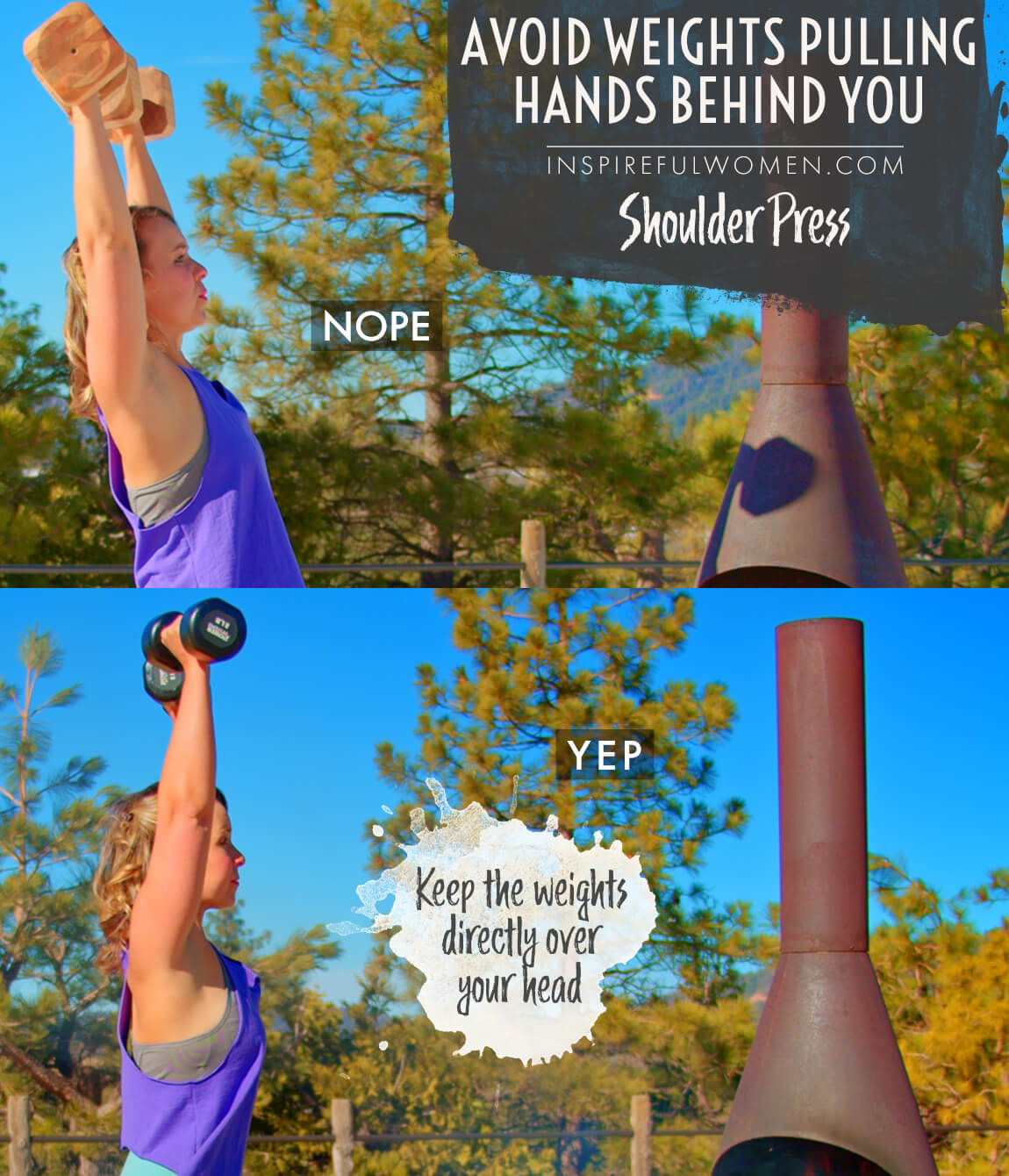
3. Avoid Bending Wrists
AVOID: Bending at your wrists.
WHY NOT?
- Poor alignment (bent forward or backward) or repetitive movement through the wrist can lead to joint and/or soft tissue irritation or injury over time.
WHAT TO DO:
- Your wrists should be in line with your forearm and should be still throughout the exercise.
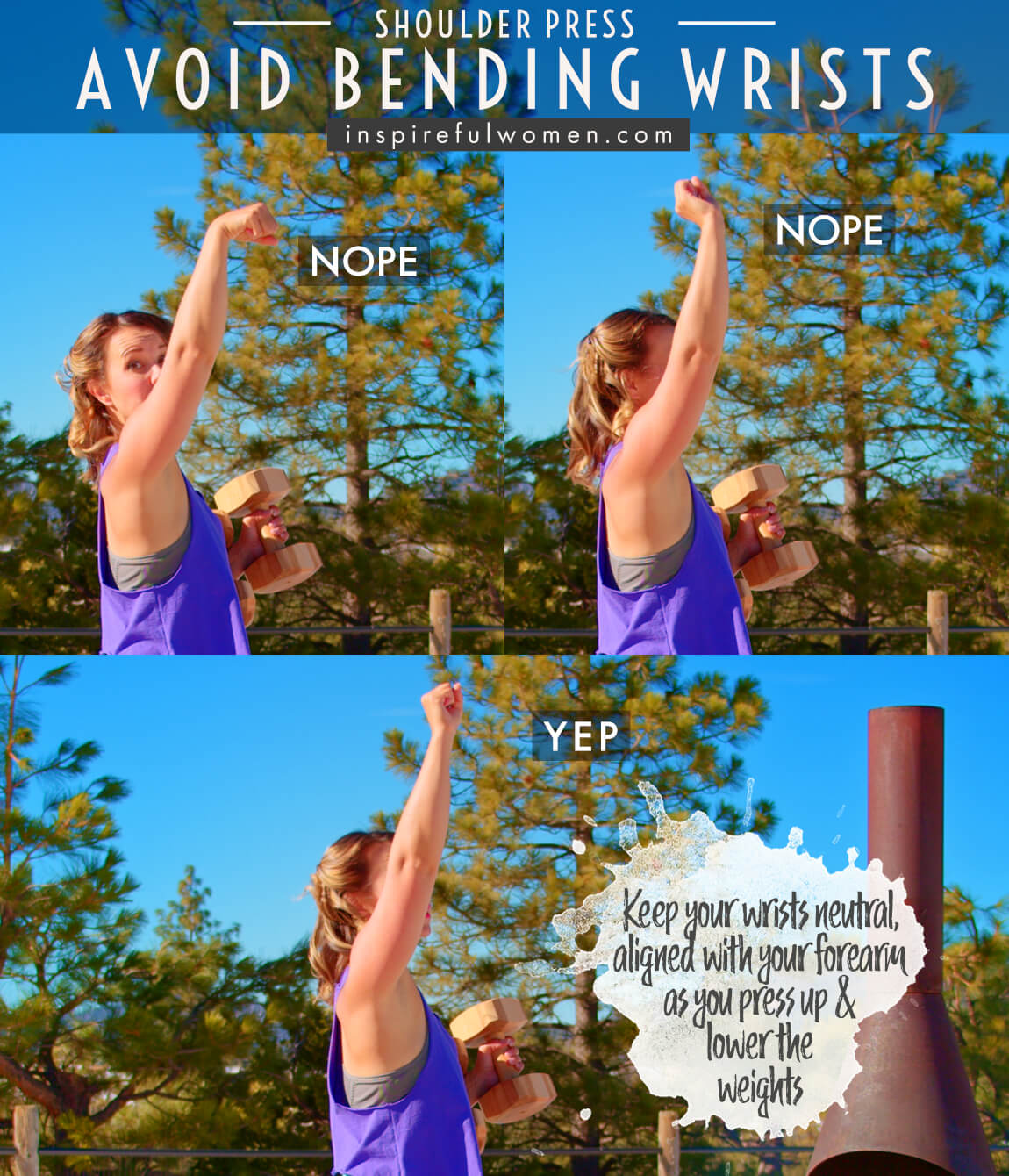
4. Avoid Angling of Arms
AVOID: Letting the arms drift out to the front or out to the side as you press up.
WHY NOT?
- Letting the arms drift to the front or the side can lead to shoulder joint strain, especially if the weight is heavy.
WHAT TO DO:
- The elbows should stay close to the ears and the hands should go straight up.
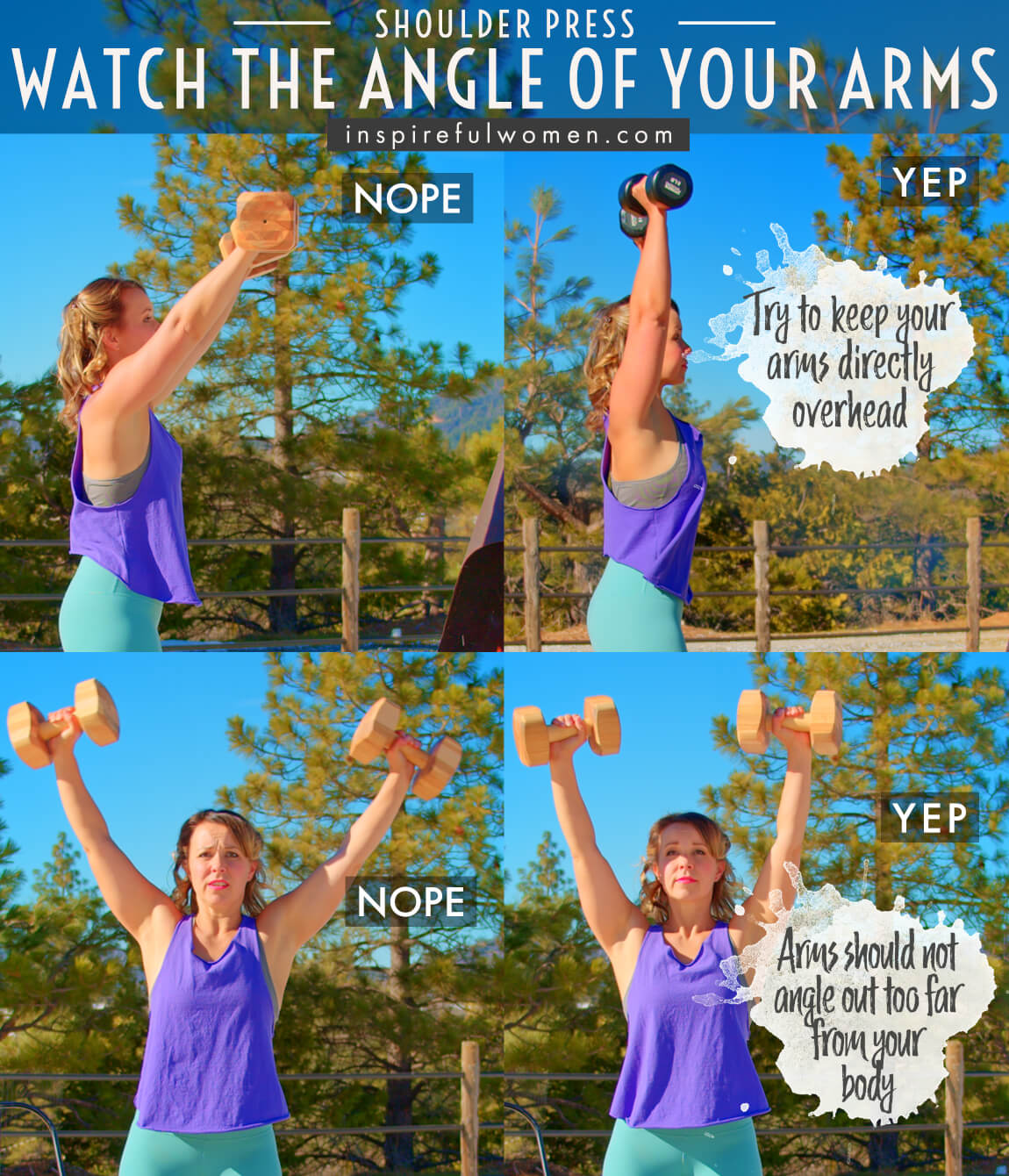
5. Avoid Hunching Shoulders Up
AVOID: Hunching the shoulders up towards the ears.
WHAT TO DO:
- Keep the space between the ear and the shoulder during the entire rep - this opens up the shoulder to avoid tendon irritation and decreases the activity of the upper traps.

6. Avoid Weight Uneven On Legs
AVOID: Unequal loading of the legs.
WHAT TO DO:
- Left and right legs should be loaded equally to ensure strengthening your core and training your balance with correct form.

7. Avoid Locking Elbows
AVOID: Locking the elbows when the arms are out straight.
WHY NOT?
- This puts too much force through the joint and may result in long-term damage over time.
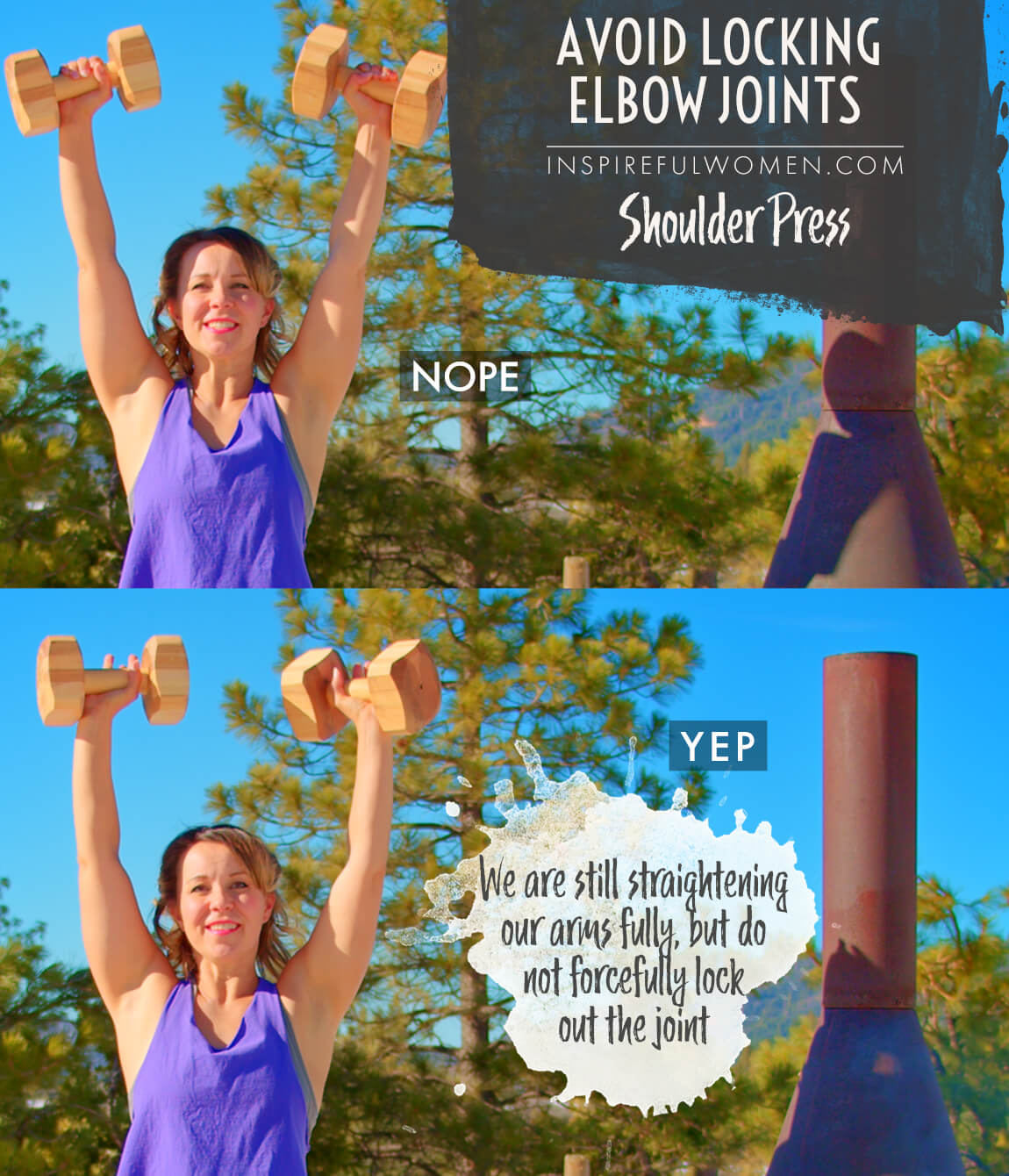
8. Avoid Using Neck Muscles
AVOID: Using your neck muscles.
WHY NOT?
- This can lead to neck strain, injury, or damage over time.
- You may feel neck discomfort, or gripping of the neck muscles.
WHAT TO DO:
- Gripping neck muscles in an attempt to stabilize the shoulders: relax the neck and activate the core muscles more.
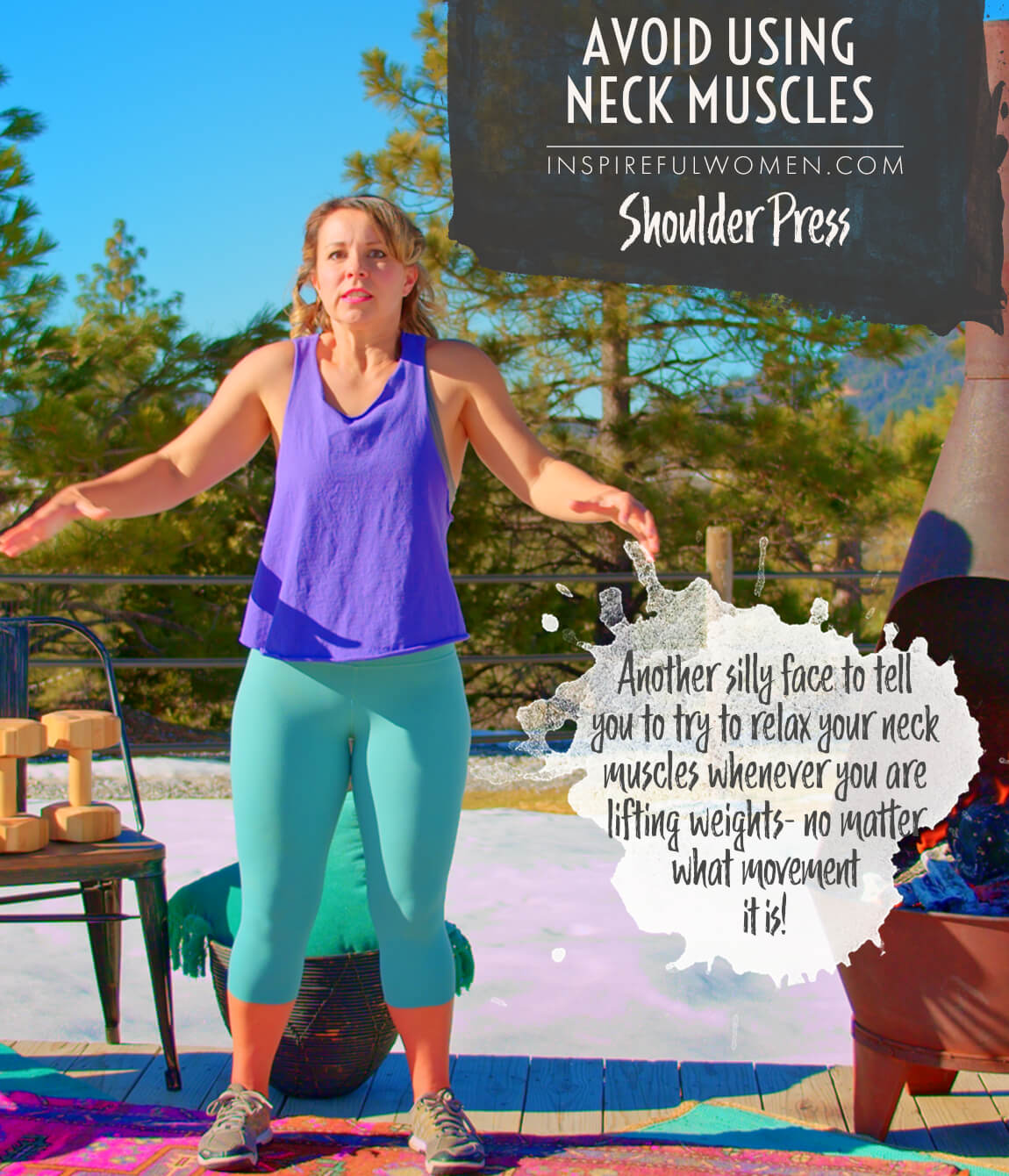
VARIATIONS
VARIATIONS
VARIATIONs OF the Dumbbell Shoulder Press
BAND + DUMBBELL
band and dumbbell shoulder press
Put a looped band around your forearms close to your hands (close to the wrists). The band should be taut in the starting position (arms moved out to the scapular plane). The external rotators and muscles of the upper back will be more active as you press the dumbbells up.
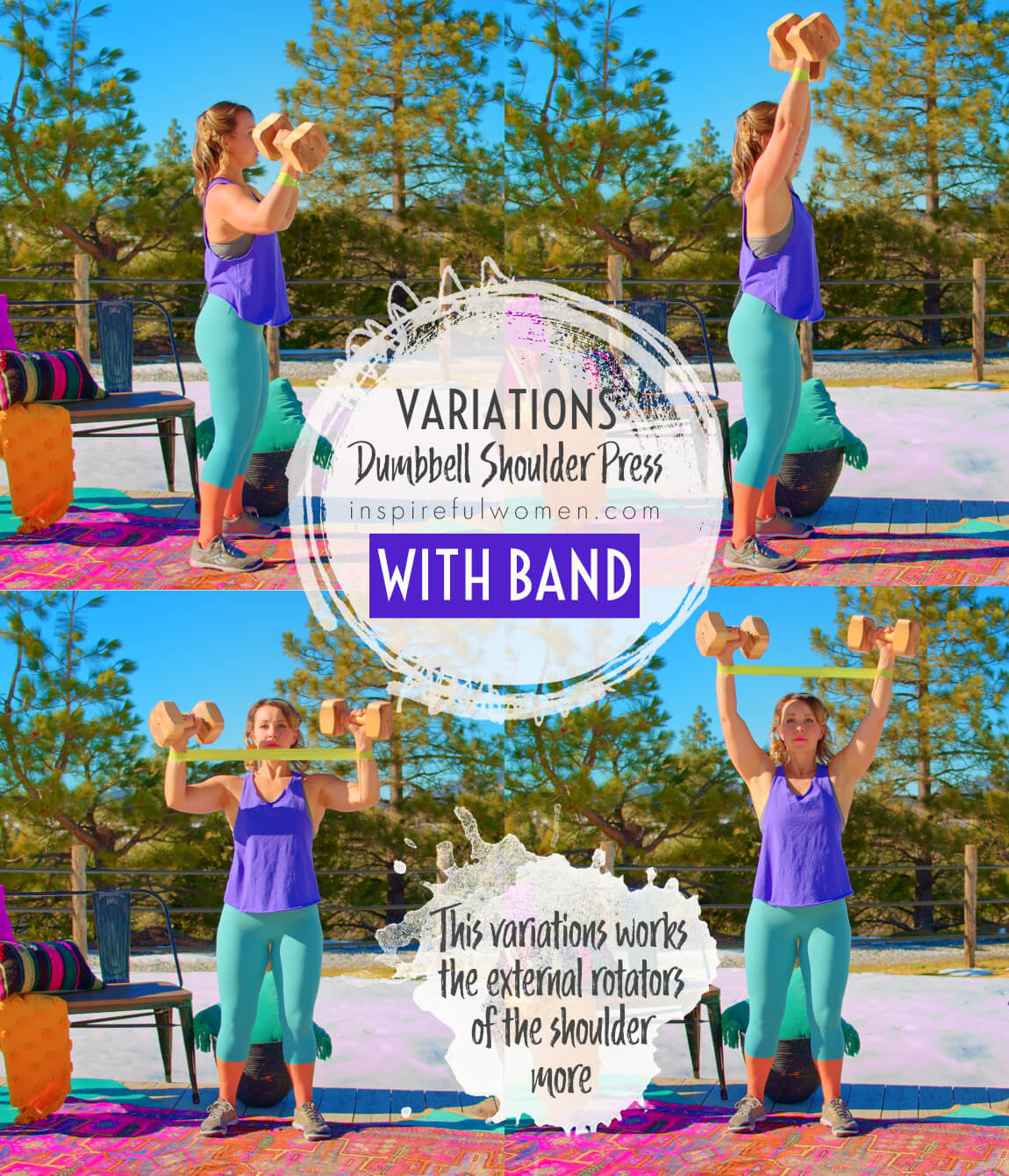
SCIENCY STUFF
SCIENCY STUFF
SPIFFILICIOUS FACTS ABOUT MUSCLES & MOVES
The scapular plane and a neutral grip are used. In this position, there is space between the head of the humerus - the upper arm bone, and the acromion process, the top part of the shoulder blade - making this the safest position for lifting heavy weights overhead.
ALLLL MUSCLES & WHEN
ALL MUSCLES WORKING & WHEN DURING THE Dumbbell Shoulder Press
The shoulder blades are down and together (latissimus dorsi, trapezius, rhomboids, pectoralis).
The rotator cuff muscles (infraspinatus, supraspinatus, subscapularis, teres minor) work to stabilize the shoulder joint as the dumbbells are pushed upwards.
The elbows are bent and the arms are holding the dumbbells at the shoulders.
As the arms begin to push up the anterior deltoid does most of the work with some help from the biceps and lateral deltoid (all working concentrically).
As the arm passes 90 degrees of flexion, the shoulder blade will begin to rotate upwards (trapezius, serratus anterior), this allows the arm to reach all the way up, overhead. The lateral deltoid becomes more active and the rear deltoid will also assist in the later part of the movement. The amount of contribution from the rear deltoid is dependent on how much weight is being used - the more weight the greater the contribution.
The triceps contract concentrically to straighten the elbows as the dumbbell is pushed toward the ceiling.
The triceps, deltoid, and biceps, contract eccentrically to control the movement as the arm is brought back down.
PIN IT FOR LATER!
